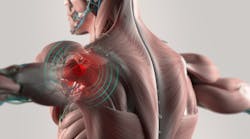While it has been shown that technology can be used to reduce workplace musculoskeletal disorders (MSD), recent research from is demonstrated to the National Safety Council suggest employers may not have the access and knowledge they need to effectively assess and implement these technologies.
To help employers navigate the evolving technology marketplace, NSC released on Oct. 4 a whitepaper Emerging Technologies for the Prevention of Musculoskeletal Disorders, to help employers navigate the evolving technology marketplace.
“Advancements in technology and automation have decreased workplace hazards to an extent undreamt of only a few years ago, but these rapid changes and a lack of clear standards for MSD-focused innovations can create uncertainty among organizations looking to adopt these tools,” said Sarah Ischer, MSD Solutions Lab program lead at NSC, in a statement.
The report references nearly two dozen academic publications to assess the benefits of the most common emerging safety technologies: computer vision, wearable sensors, exoskeletons, autonomous and semi-autonomous materials handling equipment, digital twins and extended reality. The MSD Solutions Lab also interviewed executives from a range of sectors, including agriculture, logistics and manufacturing, to better understand industry-specific MSD concerns and highlight successful applications of emerging technology.
Notable findings from the report include:
● Computer vision may be a helpful tool for large organizations, so they can more effectively aggregate and analyze ergonomic risks across an enterprise.
● In instances where implementing engineering controls is not financially feasible, workers may benefit from the use of wearable sensors, which can provide real-time haptic feedback to reduce back injuries caused by poor posture, over-reaching and improper lifting.
● To reduce MSD risk caused by manual materials handling, organizations may consider adopting passive exoskeletons, which have shown to reduce muscle activity by up to 40% and, in one case study, decreased worker fatigue by 45% and boosted organization output by nearly 10%.
● While Industry 4.0, characterized by the widespread use of computerization, big data and AI in the workplace, is still ongoing, the next phase of advancement – Industry 5.0 – has already begun, prompting employers to dedicate a greater emphasis on harmonizing human ingenuity and automation in the workplace.
Given that MSDs – such as tendinitis, back strains and sprains, and carpal tunnel syndrome – are the leading cause of worker disability, involuntary retirement and limitations to gainful employment, the MSD Solutions Lab is using several paths to address this issue including including an advisory council, additional pioneering research, innovation challenges and grant program.

